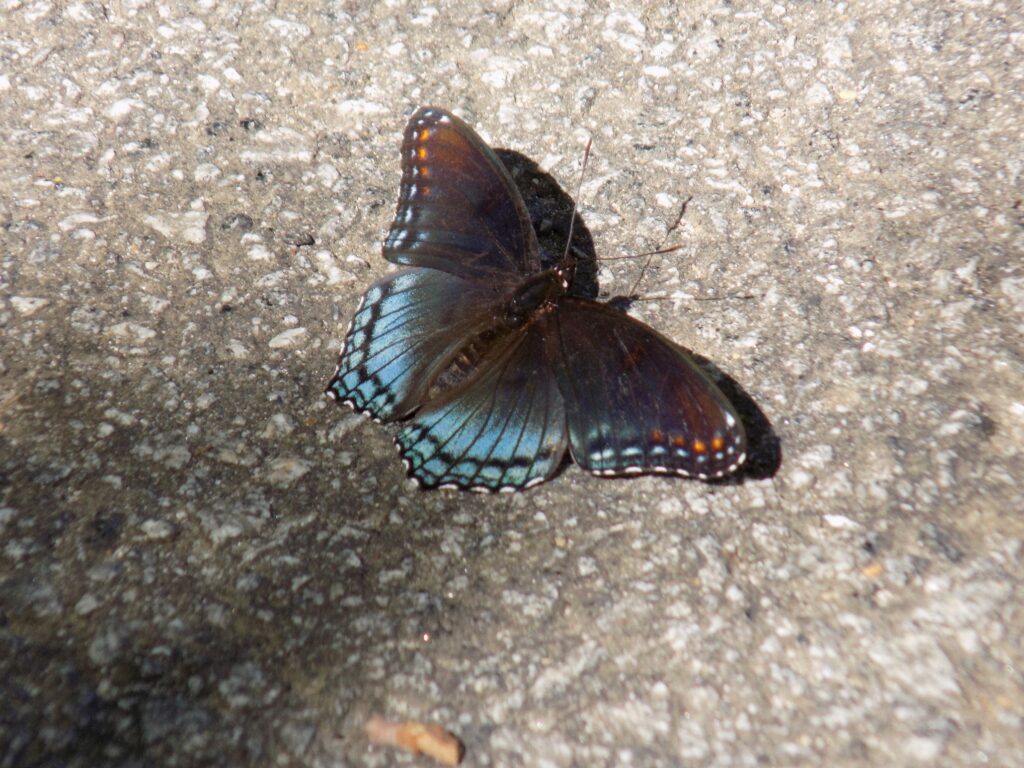
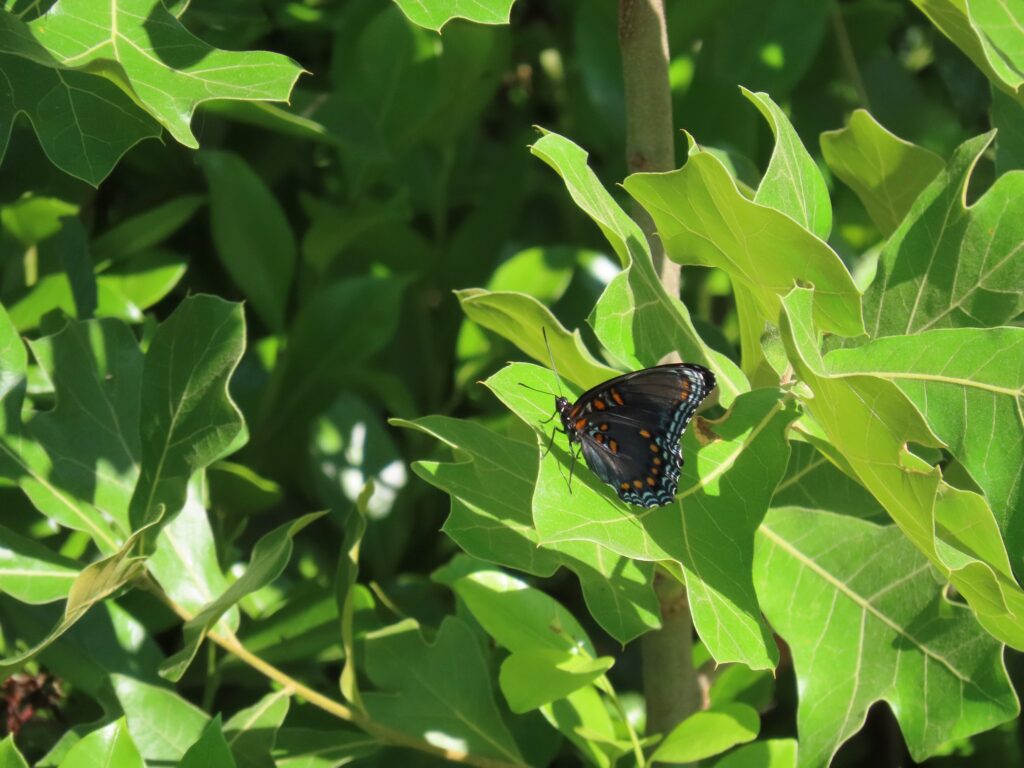

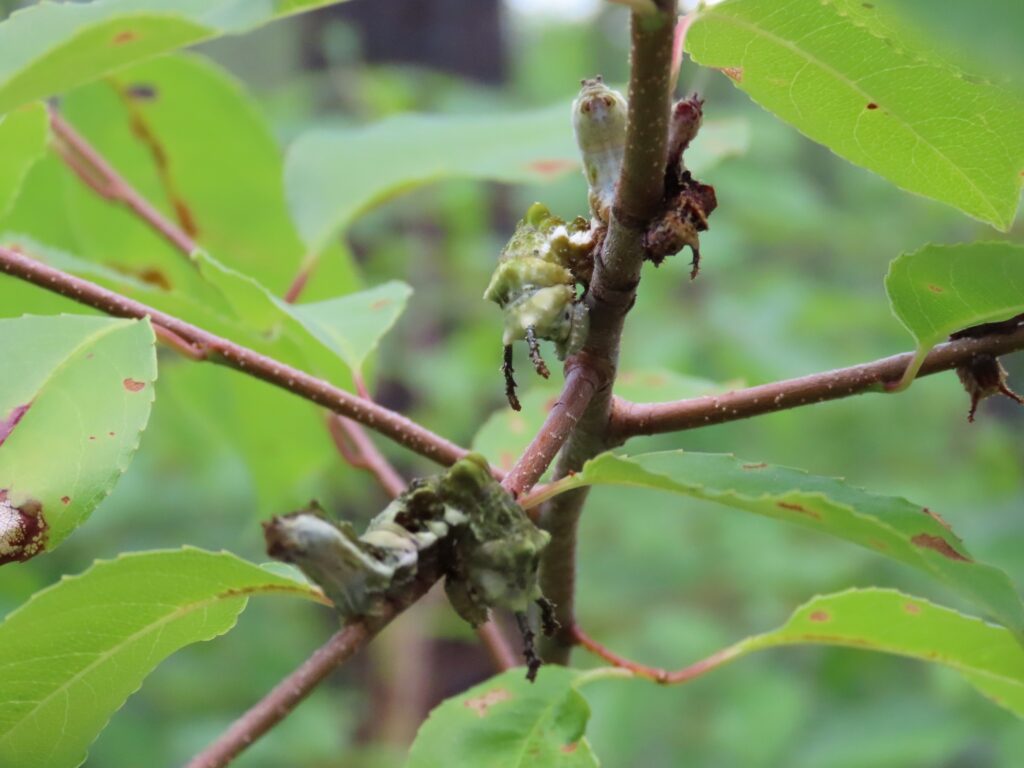
This week for Flora and Fauna Friday we’ve got a two-faced cherry-picking butterfly, the Red-spotted Purple (Limenitis arthemis astyanax).
The Red-spotted Purple is a common woodland butterfly found throughout the Eastern United States. It’s a moderately-large butterfly found along forest edges, dirt roads, walking trails, and orchards. They are partial to landing on bare ground to lap up minerals from damp soil. You’re just as likely to see them on the ground as you are on a flower, and they’re hard to miss! The Red-spotted Purple has a black base color. On the top of the wings it is washed in a vibrant sky-blue iridescence. This blue and black is complimented by fine white marks on the wing margins and a handful of orange spots at the tips of the forewing. Underneath, bold orange spots dominate the pattern, flanking the wing margins atop waves of powder-blue crescents in a sea of faint, blue iridescence. They are one of our most striking butterflies. The Red-spotted Purple’s caterpillars host on several groups of woody plants including willows, blueberries, and cherries. Black Cherry is their preference around Edisto Island. Both the larvae and pupae of Red-spotted Purples mimic bird droppings.
The Red-spotted Purple is a subspecies of the White Admiral (L. arthemis), which is found along the Great Lakes and in New England. The two subspecies have markedly different color patterns but are still all one species. The White Admiral has a heavy white band across each set of wings. This white band is totally absent in our Red-spotted Purple, instead replaced by extensive blue iridescence. The red-spotted Purple is in the same genus as the Viceroy (L. archippus) and these two species share similar body shapes, behaviors, and ecologies. One of those shared traits is mimicry. The Viceroy mimics the toxic Monarch and the Red-spotted Purple mimics the poisonous Pipevine Swallowtail. Interesting to note is that the Red-spotted Purple’s range stops and the White Admiral starts at the same latitude where the Pipevine Swallowtail’s range ends. So the mimicry clearly offers an advantage to the species in the South but must be a hindrance in the Northeast.



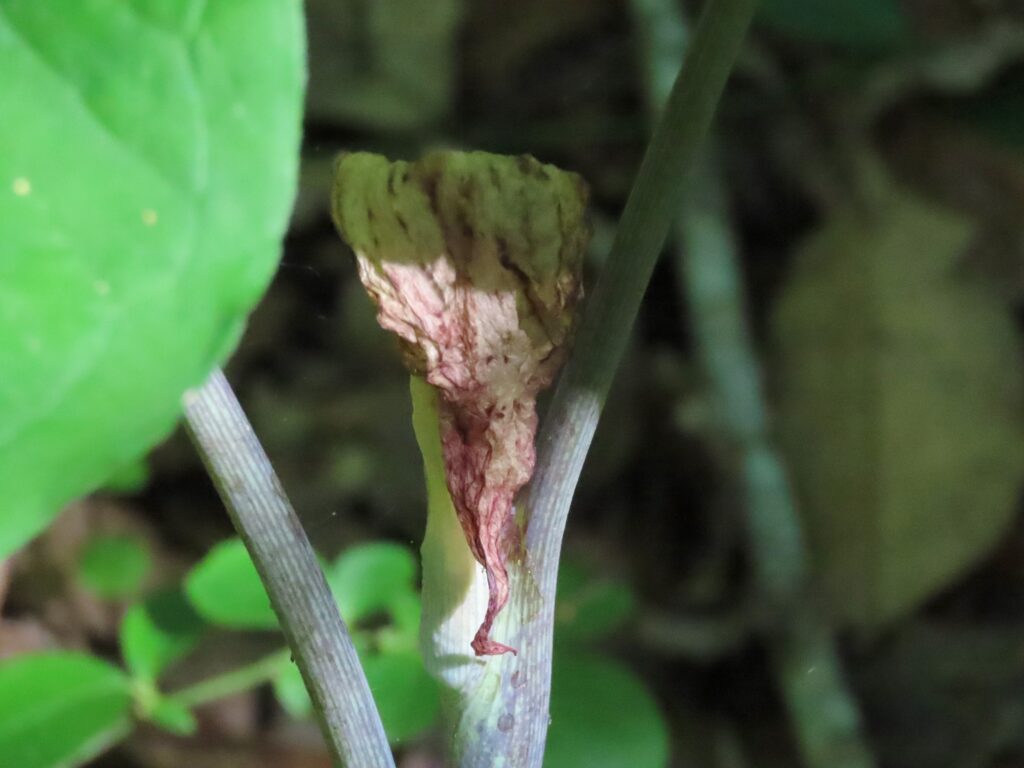
This week for Flora and Fauna Friday we have a widespread wildflower of wet woodlands, Jack-in-the-pulpit (Arisaema triphyllum).
Jack-in-the-pulpit is a perennial wildflower found throughout the Eastern United States, to include Edisto Island. It grows most commonly in shady woodlands with a sparse understory. There it crops up singly or in a small colony within depressions and damp spots in the soil with a high water table. Jack-in-the-pulpit is an easy plant to identify. It has large three-lobed leaves that emerge straight from the ground, generally in pairs, with each leaflet being angled roughly ninety degrees apart from one another and the whole leaf reaching a foot or two above the ground. Below these leaves emerges a unique flower for our uplands.
Jack-in-the-pulpit is a member of the Arum family, Araceae. Arums are best known for their large leaves and unique flowers. Arum flowers have two distinctly visible parts, an outer spathe and an inner spadix. The spadix is a spike that contains the real flowers, both male and female. The spathe is an outer covering that wraps around and protects the spadix and functions a bit like petals and sepals do on other flowers. It also acts as a funnel to channel pollinators down to the true flowers. In Jack-in-the-pulpit, the flower stands upon its own vertical stalk and is a pale green cup with longitudinal stripes. Those stripes are either a darker green or a deep burgundy. The spathe wraps the whole way around the spadix and curls down over the top to form a hood. From within the spathe the rounded tip of the spadix peeks out. This uniquely shaped flower is where the Jack-in-the-pulpit name comes from, as the bloom looks like a man (assumedly the fella’s name is Jack) peering out from an elevated gothic-style pulpit. Jack-in-the-pulpit blooms in mid-spring. Its flowers are pollinated by tiny fungus gnats. Flies are the target pollinators for most Arums. Arum flowers go so far as to emit specialized scents and their spadix even generates its own “body” heat to attract to attract flies! Jack-in-the-pulpit is no exception there. Once pollinated, the flower matures into a cylindrical cluster of bright red berries.
Lastly, Jack-in-the-pulpit is a species complex containing five separate subspecies. Each of these subspecies has discernable physical characteristics, differences in their ranges and ecologies that keep them reproductively isolated, and genetic variation. Many botanists consider them separate species while many others consider them just subspecies. However, as far as I can figure, here in the South Carolina Lowcountry we have but one of these subspecies, the traditionally named Jack-in-the-pulpit (Arisaema triphyllum).

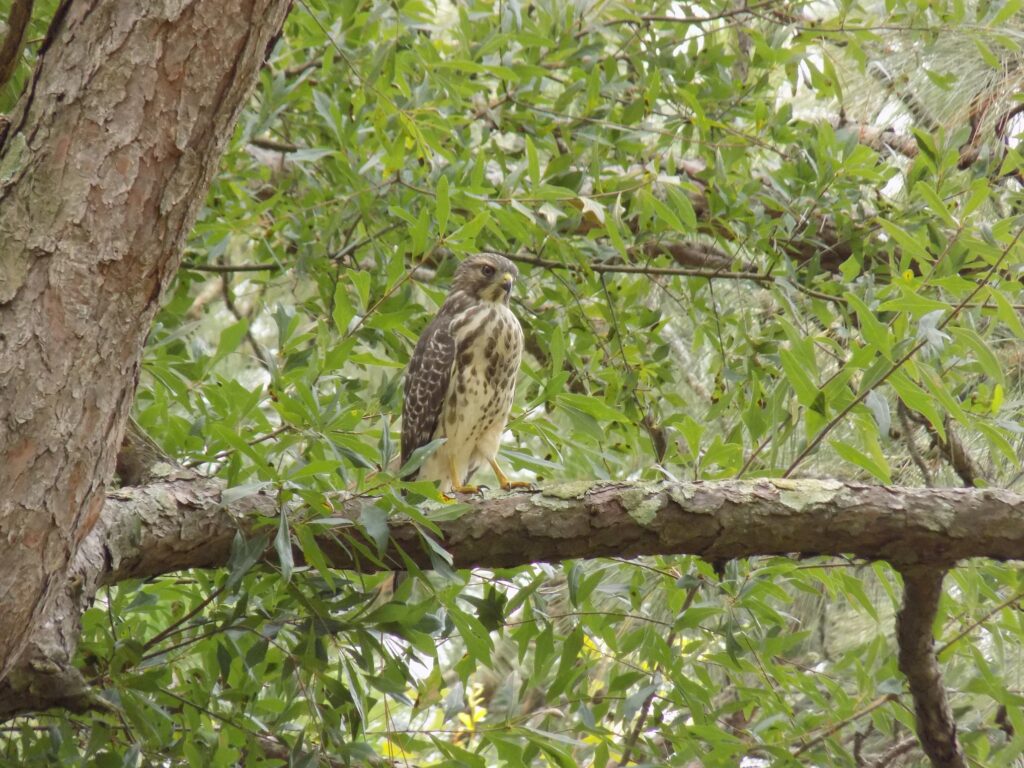

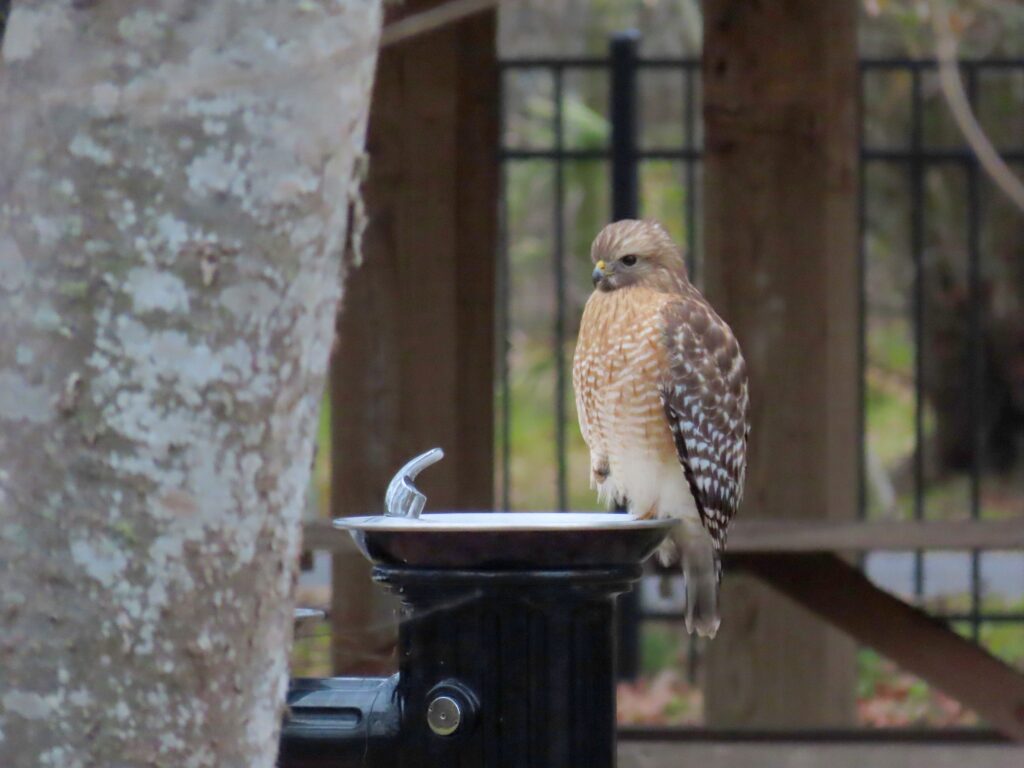
This week for Flora and Fauna Friday we’re gazing upon our most reliable resident raptor, the Red-shouldered Hawk (Buteo lineatus).
The Red-shouldered Hawk can be found year-round across the Southeast and the state of South Carolina. Compared to some of our other birds of prey, its abundance remains consistent and high throughout the year. Meaning this is the most likely raptor for you to spot across the Lowcountry. They’re not a hard hawk to identify either. They’re about average size for our raptors, bigger than a Cooper’s Hawk but smaller than a Red-tailed Hawk. Adult birds have rust-red shoulder patches, a rusty-orange belly broken up by fine white bars, and a black tail with several thin white bars. On the wing, they can easily be picked out by the “windows” at the tip of the wings. These are distinct translucent, half-moon-shaped patches in the feathers that brighten against a sunny sky. The call of the Red-shouldered Hawk is unmistakable as well, a loud descending scream repeated a half dozen or more times in short order. They’re not shy about calling either and can be heard vocalizing far and wide. However, our Blue Jays love to imitate the Red-shouldered Hawk’s call and they’ve got a spot on impression too. The best way to sort out the real deal hawk hollerin’ is by paying attention to the depth and the breadth of the screaming. Blue Jays are much smaller and don’t have as much bass behind their call. They also don’t commit to the bit entirely and often stop after just two or three shouts. Red-shouldered Hawks are partial to open woodlands and clearings. However, they can be found practically everywhere from swamps to savannas and from farm fields to suburbs. They hunt from a perch, waiting and watching for motion, before diving down to grab their prey. Red-shouldered Hawks eat a variety of prey including songbirds, rodents, frogs, lizards, snakes, and large insects.
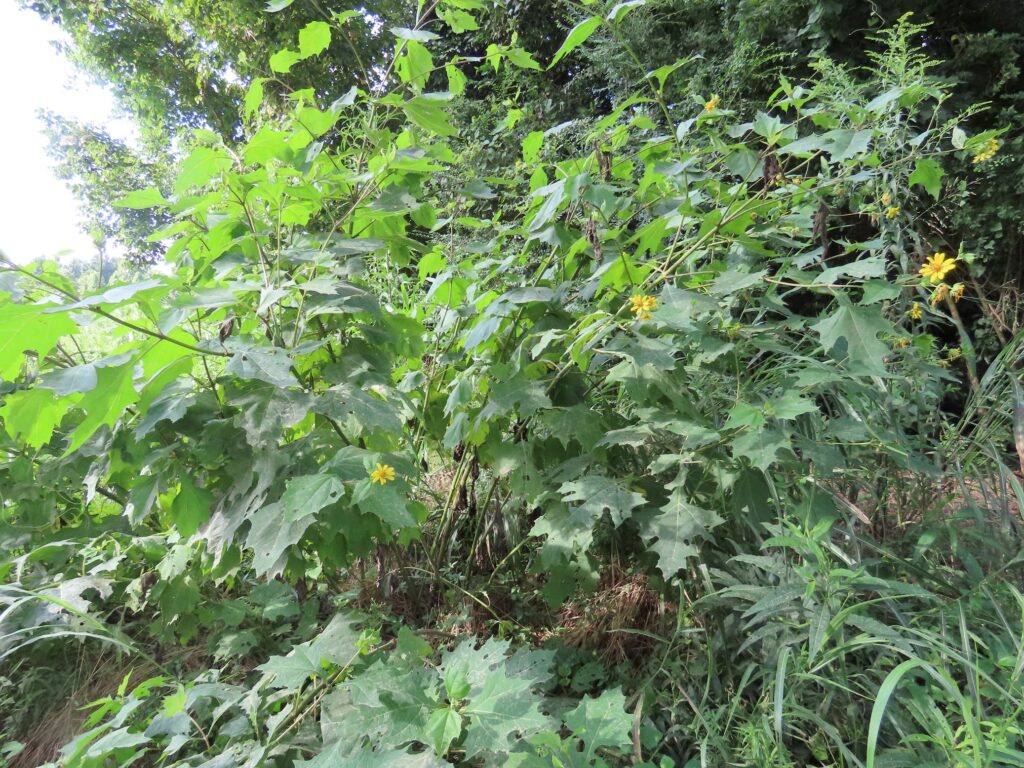
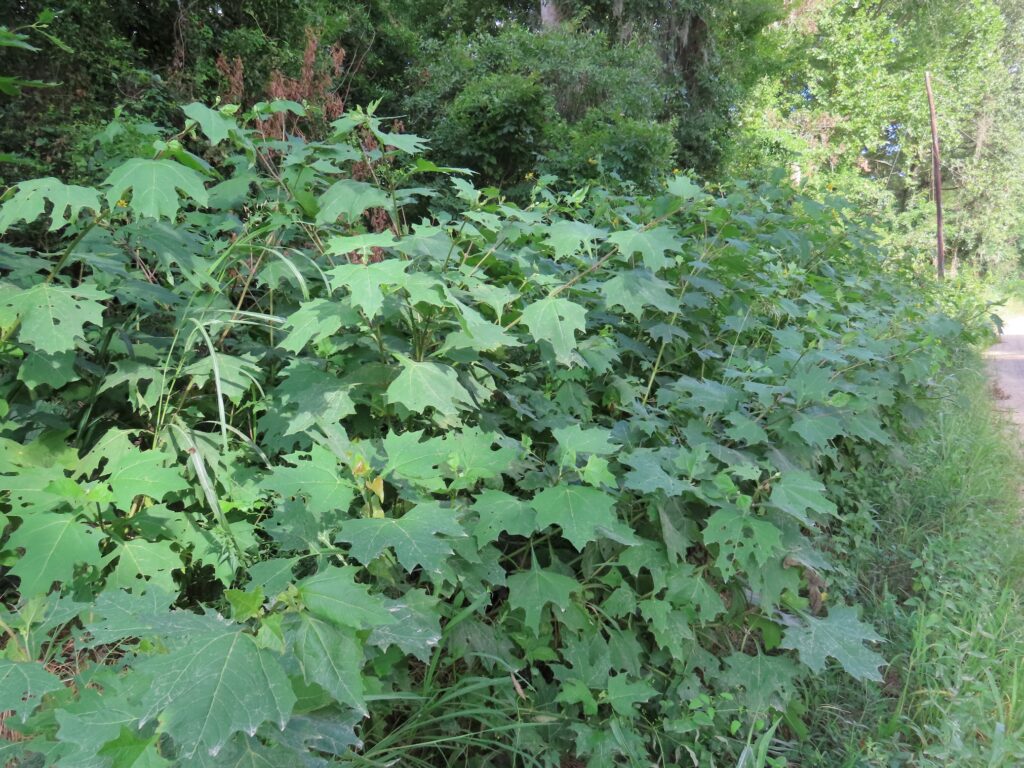

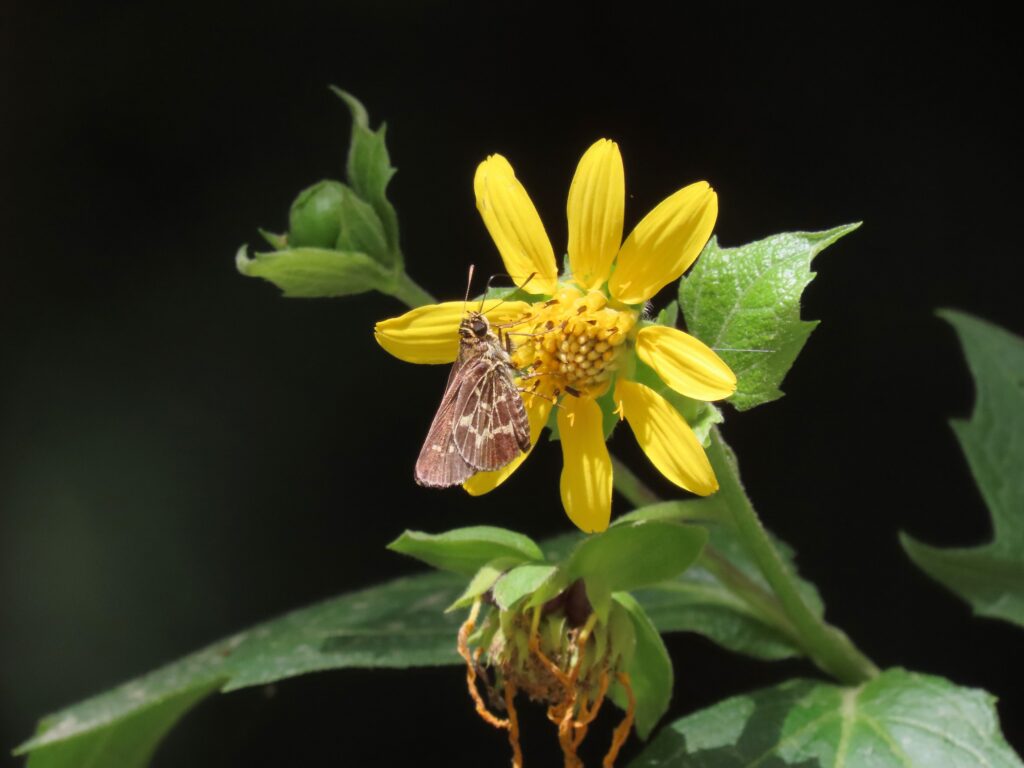
This week for Flora and Fauna Friday we have a large and leafy pollinator plant, Hairy Leafcup (Smallanthus uvedalia).
Hairy Leafcup, also called Bear’s-Foot, is a large perennial wildflower in the sunflower family, Asteraceae. It’s found throughout the Southeast, nearly all of the state of South Carolina, and is common along roadsides on Edisto Island. Hairy Leafcup prefers moist soils on shady forest edges. Ditch banks and the shoulders or dirt roads are a particularly preferred habitat, but it is hardy and will readily live in many environments. Hairy Leafcup grows into a multi-stemmed bush, generally reaching about head high but can add a couple extra feet to that in ideal conditions. It spreads laterally to form thickets. It has large, opposite, papery leaves that can reach a foot in width. Hairy Leafcup is best spotted by its flowers, which can emerge as early as May and can continue through September but peak in late June. Hairy Leafcup’s flowers are an inch and a half wide with lemon-yellow petals and a more golden center. Flowers emerge at the tips of the stem in loose clusters. These flowers are well-loved by all pollinators and produce both pollen and nectar in abundance. Its hollow stems also provide great nesting habitat for cavity nesting bees and wasps the following year. Hairy Leafcup can be a good pollinator planting but usually needs its own space by itself. These plants also create great wildlife habitat, as their height and broad leaves provide cover for all manner of critters to hide and its seeds are eaten by many species of songbird.
This week for Flora and Fauna Friday, it’s our once prolific, pint-sized partridge, the Northern Bobwhite (Colinus virginianus).
The Bobwhite is our resident species of quail found throughout the Southeast and Mississippi River Basin. They’re about the size of a Mourning Dove but taller and stockier. Bobwhite have a small round head, short but heavy beak, football-shaped body, stubby tail, and strong legs. Both males and females are cryptically colored with an intricate mottling of black on white across the belly that bleeds up into the rust-washed flanks and folds below a nigh kaleidoscopic slurry of camouflaged grays and browns over the back. Males wear a white beard, black mask, heavy white eyebrow, and dark speckled cap. Female have a similar facial pattern but of golden and neutral browns. Due to their small size and cryptic coloring, quail are tough to get a good look at. However, they’re not hard to hear. The male sings an unmistakable whistle of “bob-Bob-WHITE” that rings across the countryside, like a church bell on Sunday morning, and gave the Bobwhite its common name. Bobwhite are ground birds and spend their entire lives walking, foraging, and nesting on the ground. There they feed on insects, seeds, fruits, and vegetation. Being a bite-sized biddy your whole life has its downsides. To compensate, quail live in groups, called coveys, which are comprised of a handful of birds at the low end and up to several dozen on the high end. Living in groups increases the number of eyes on the lookout for predators and helps the birds escape harm. When startled, coveys explode out of cover and take to the air, flying to better cover a distance away. Bobwhite have particular habitat needs, which helps assure they have ample food and cover in the right types and quantities year-round. This gives them the best opportunities to hide and escape from predators, as well as the chance to raise a nest of young ‘uns. Bobwhite are most commonly found in pine savannas, fallow fields, grasslands, clear-cuts, and the borders of crop fields. All big open areas with lots of vegetation. However, their habitat requirements are not as simple as they sound and they need very specific conditions, consistently, across huge areas for populations to remain stable. This makes Bobwhite sporadically common on the landscape nowadays and more often than not a pleasant surprise to find, rather than a guarantee.
However, the Southeast was once thick like rats with Bobwhite. Their coveys littered fields and savannas in every corner of the South and a rich hunting tradition evolved around the quail. However, Bobwhite rapidly started disappearing from the landscape in the 1970s. The reasons for this are complex and not fully understood. However, it’s thought to boil down to habitat loss, degradation, and fragmentation. In order to thrive, Bobwhite need grasslands and other brushy open areas to be maintained in diverse conditions in large interconnected matrixes across the landscape. Historically, farms provided a lot of this habitat within their row crops, on their margins, in the fields left fallow for rotation, and in the regularly burned pine woods and forests that surrounded them. All these farms then abutted each other across the entire Southeast to create one giant network of suitable Bobwhite habitats. Over the years as new technologies were invented, farms progressively increased their land use efficiency. Meaning they got bigger, more orderly, left less land out of cultivation, and became cleaner. Particularly, the advent and widespread use of modern selective herbicides and insecticides also meant there were less weeds and insects in and surrounding farm fields, removing important quail cover and food. Simultaneously, the number of farms and the amount of land in agriculture shrank. To cap it off, the anti-forest fire campaigns that started in the 1950s sought to wipe low-intensity prescribed fire from the southeastern landscape, in a misguided effort to prevent wildfires back before we understood the ecology of these fire-adapted systems. These factors all in combination started eroding Bobwhite habitat from every angle, until a tipping point was hit and quail populations started rapidly evaporating across the United States. Over the last 50 years, great efforts have been taken by all manner of federal, state, and local natural resources agencies to study quail populations and habitat, and many nonprofit organizations and conservation programs were founded to halt the decline of Bobwhite and other upland game bird species. Many Bobwhite populations across the Southeast have stabilized and the species as a whole is no longer in immediate danger. However, as the core landscape and land uses of the Southeast have changed dramatically, and continue to change, Bobwhite will almost assuredly never return to their historic abundance. Yet, with any luck, we can continue to make strides towards making room for them in the Lowcountry once again.
It’s Pollinator Week, a time to think about, appreciate, and help out the pollinators who keep agriculture and ecosystems going behind the scenes! We all know honeybees, bumblebees, and butterflies and appreciate the pollinating they do, but do you know all the other critters that pollinate?
Beyond honeybees and bumblebees, we also have myriad species of native solitary bees who are every bit as important as their social cousins. Our native leafcutter, miner, digger, cellophane, sweat, and carpenter bees all carry their weight in pollinating not only our native plants but our garden vegetables, fruit trees, and agricultural crops. They’re often specialize for certain groups of plant and time their emergence to when these plants are blooming.
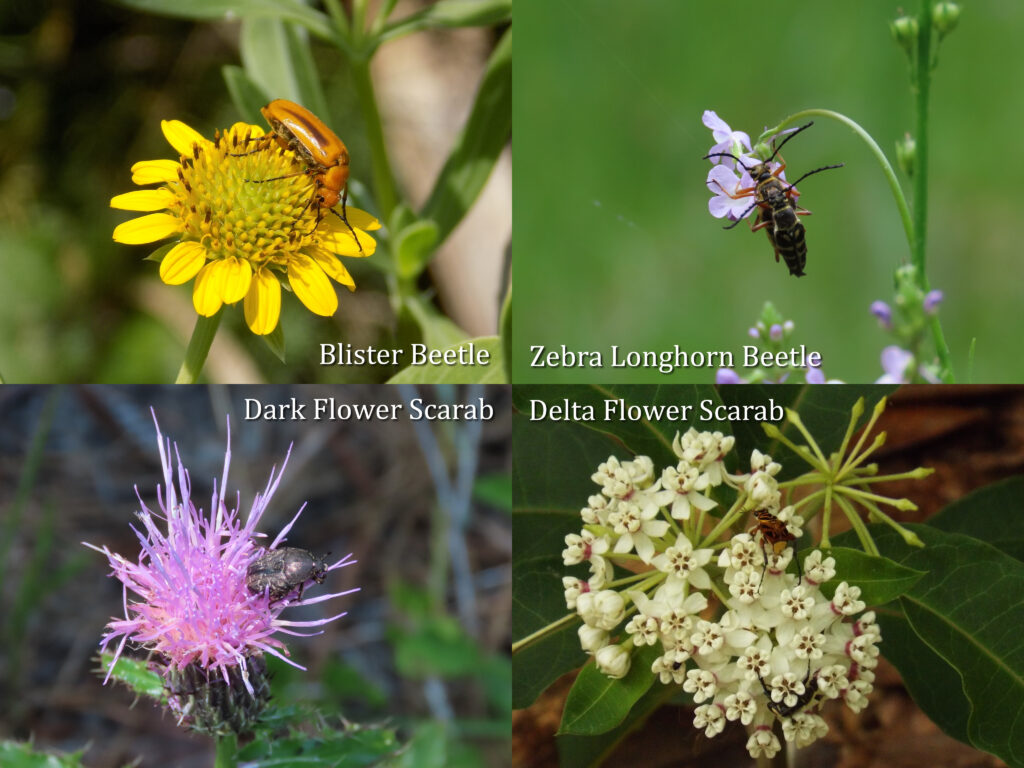
Beetles were the world’s first pollinators and still play an important part in pollinating many species of wildflowers as well as magnolias. Beetles lack the coordination and efficiency of other pollinators but their size and posture mean they get coated head to toe in pollen before moving to another flower.
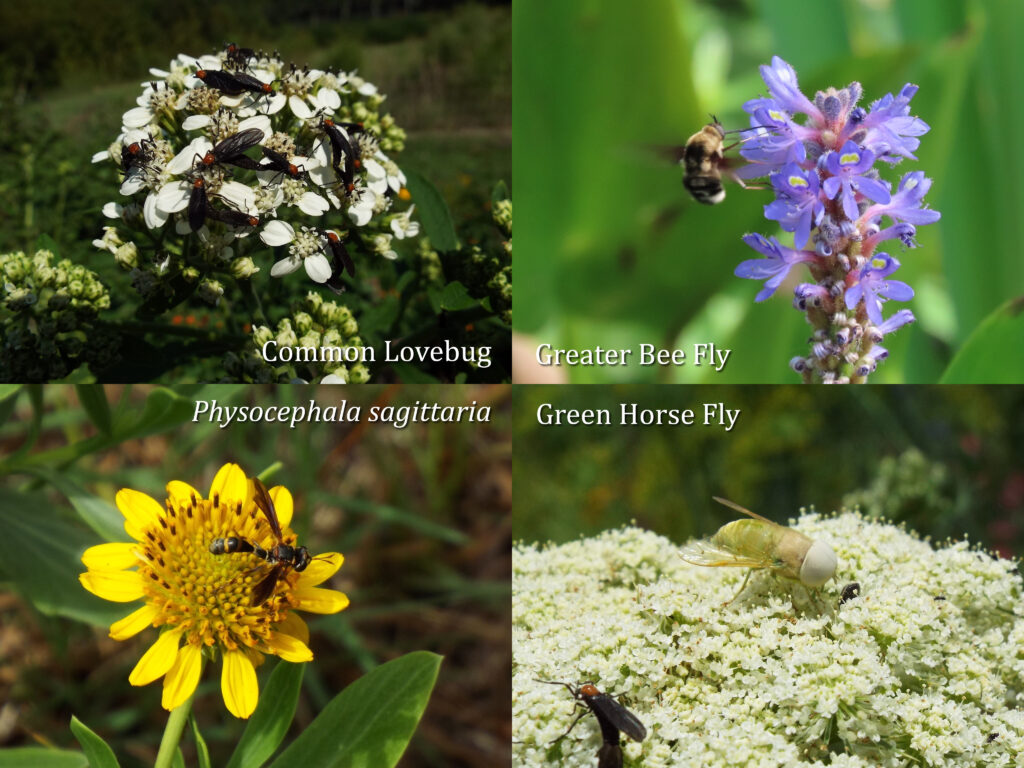
Flies of all shapes and sizes fill a vital role in pollinating small flowers. Many flies are small and agile, allowing them to precisely move between tiny, spaced-out flowers. Other flies, like Lovebugs, emerge in swarms and clumsily crawl across flower-heads from all manner of plants, pollinating as they go.
Ants are a key pollinator of many low-growing plants, like Wild Ginger. Although not a common pollinator they are critical to the survival of these plants. Other plants have developed ways to enlist ants for guard duty. These plants secrete nectar from their leaves, stems, or elsewhere in order to convince ants to patrol their stems and attack any pests they encounter.
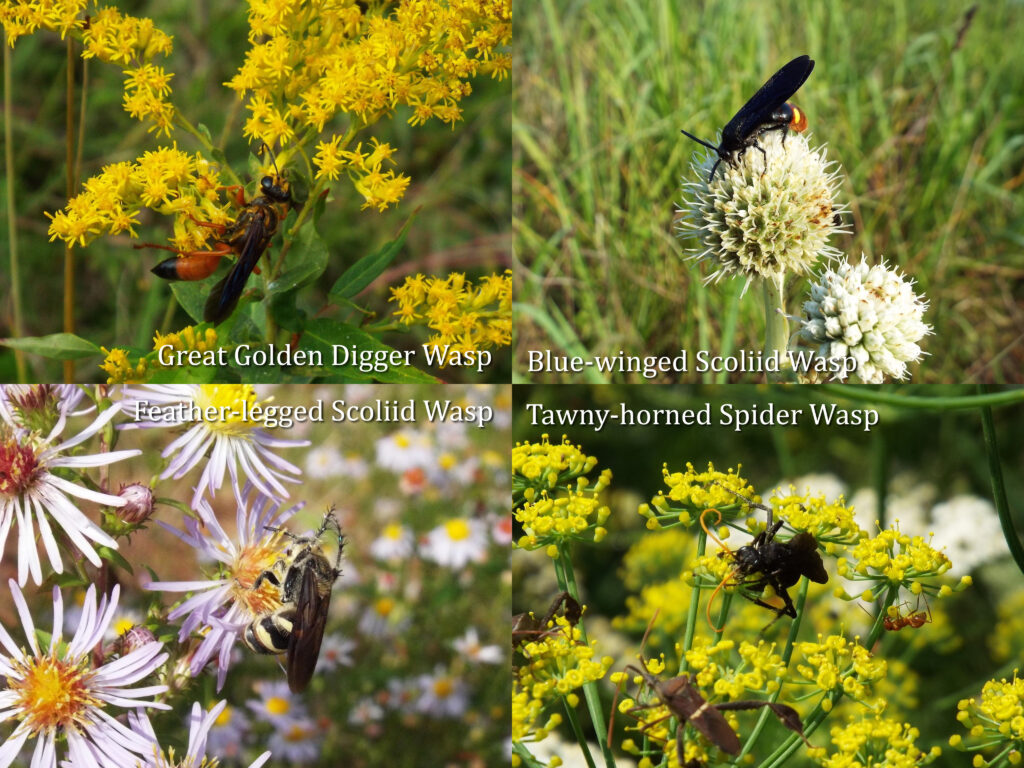
Wasps are our most under-appreciated pollinators. Wasps are a very diverse group with varied life histories. Many rely heavily on nectar and pollen to survive and act as vital pollinators in the process. Other species pull double duty, where adults drink nectar and pollinate flowers as they patrol for caterpillars and other arthropods. They capture these potential pests and bring them back to feed to their young, helping control crop pest populations in the process.
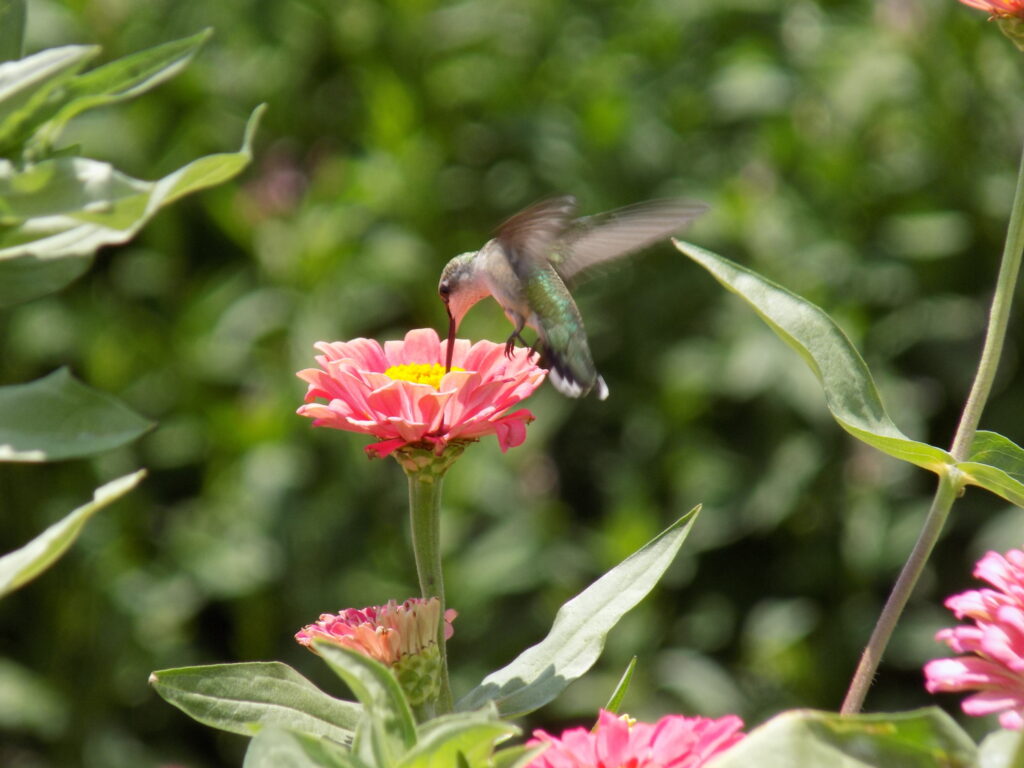
Last but not least, Ruby-throated Hummingbirds have formed mutualistic relationships with many species of wildflower in the Southeast. These plants have shaped their flowers so that only hummingbirds can use them. In exchange for nectar, the hummingbird’s head is dusted in pollen that it carries with it to other plants in the area.
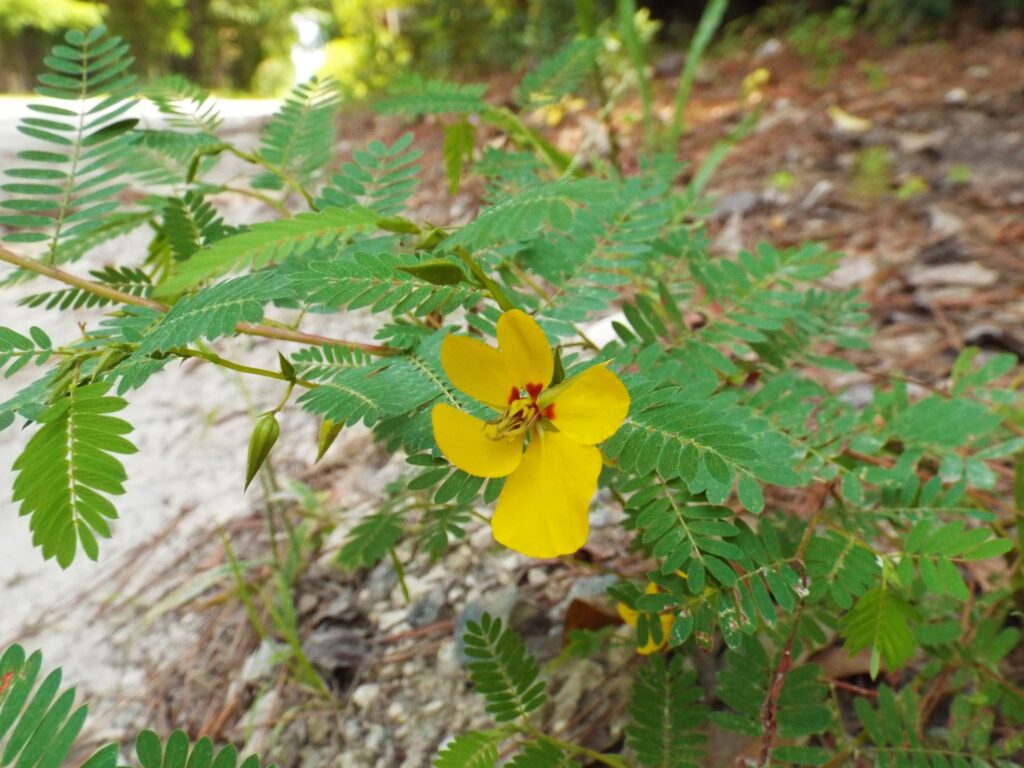
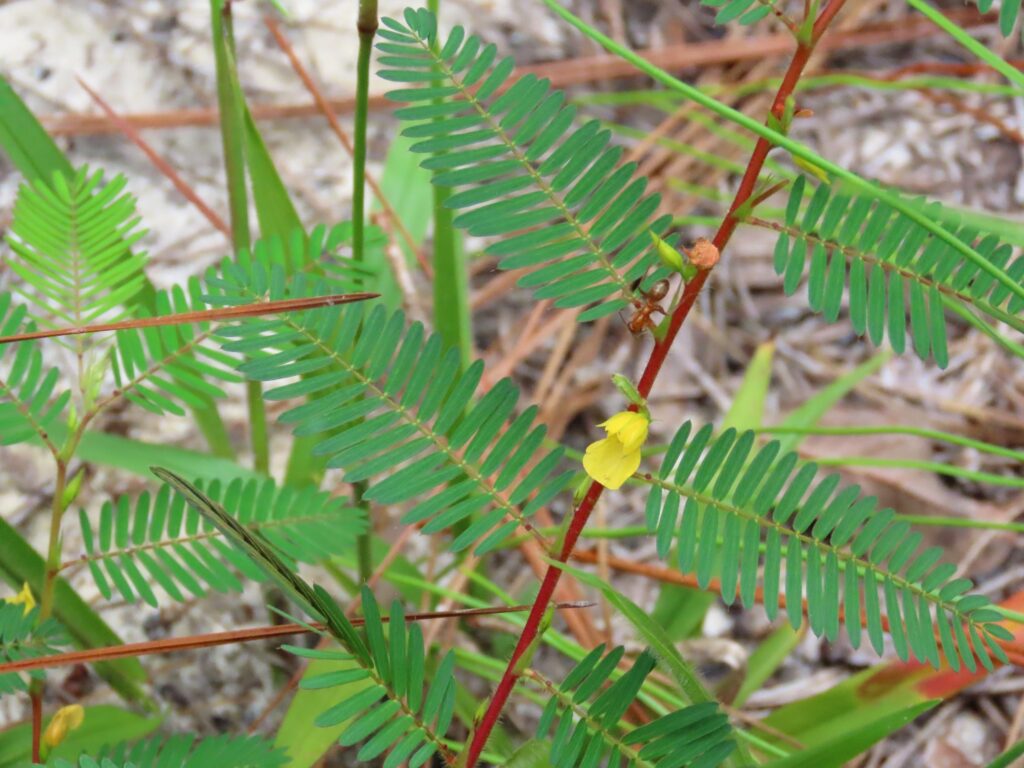


This week for Flora and Fauna Friday, it’s another large lanky legume of ecological significance, the Partridge Peas (Chamaecrista spp.).
Partridge Pea (C. fasciculata), and its smaller bashful brother Sensitive Partridge Pea (C. nictitans), can be found all across South Carolina and the Southeast. Partridge Peas grow most often in disturbed areas, like field edges, roadsides, clear cuts, power line right-of-ways, and burned forests. Partridge Pea can thrive on practically all our soils but Sensitive Partridge Pea is best adapted to sandy soils. Both species are annuals that are very similar in appearance, except that Sensitive Partridge Pea is smaller in size, only growing about a foot tall, and with smaller leaves and flowers. Partridge Pea is a large, sprawling annual legume that can grow into a head-height bush. Its leaves are finger-length and feather-shaped and its stems can be a vibrant red in sunny habitats. The flowers are an inch wide, five-petalled, and golden-yellow with crimson spots near the center. Additionally, the leaves of both species will fold up flat when touched! The fruit of Partridge Pea is a narrow flat bean full of square, black seeds. These seeds have made the plant a critical cornerstone in many wildlife management plans.
Partridge Peas, as the name implies, have some link to partridges, or what we refer to as quail in America. In the South Carolina Lowcountry we have but one quail, the Northern Bobwhite (Colinus virginianus). Bobwhites love Partridge Pea seeds. They are highly nutritious and sustain many a quail through the winter. The plants themselves also provide great cover for quail from aerial predators as they forage. As such, Partridge Pea is a great addition to any habitat restoration project and its management is a significant concern for property owners and wildlife managers interested in restoring and managing for Bobwhite populations. The benefits don’t stop with quail either, as many wildlife eat its seeds and leaves or take cover under its boughs. Today’s plant is also the host plant for several butterfly species, including the Cloudless Sulphur, Little Yellow, and Ceraunus Blue.
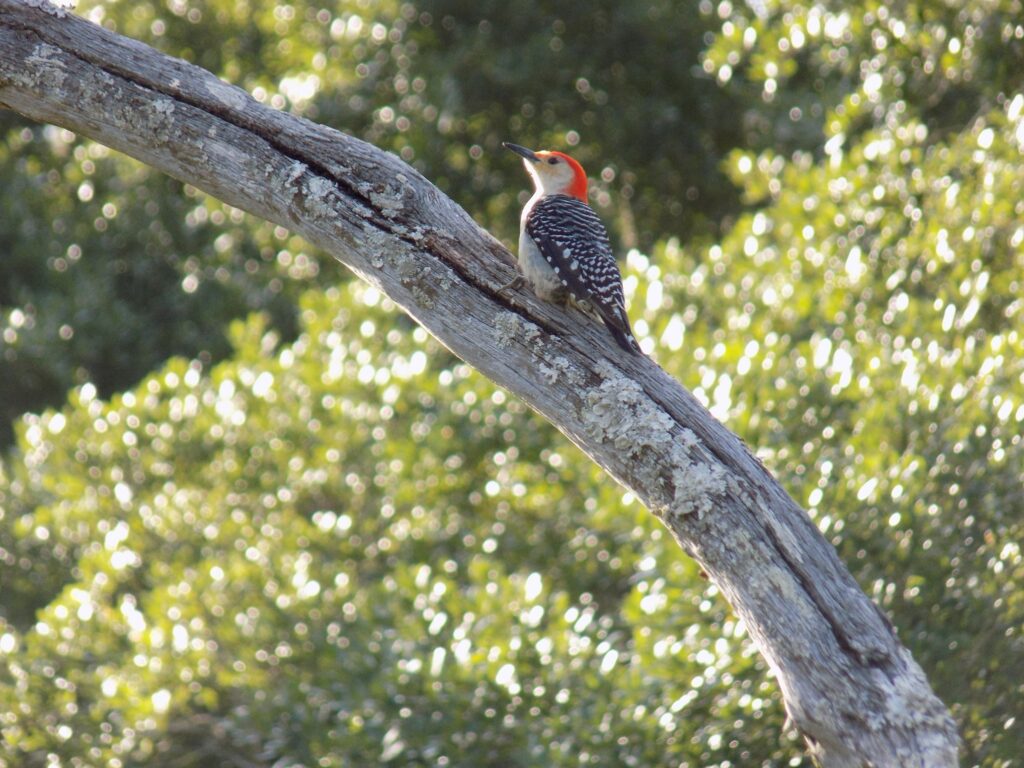

This week for Flora and Fauna Friday, we have our resident red-necked feeder frequenter, the Red-bellied Woodpecker (Melanerpes carolinus).
Red-bellied Woodpeckers are residents of the Eastern United States. They’re a common sight in nearly every corner of South Carolina, so long as there are trees. Red-bellied Woodpeckers are a medium-large species of woodpecker that shares the stereotypical red, white, and black woodpecker plumage. They don a cape of black rippled with thin white stripes down the back and cover their head and neck with a scarlet cowl. The cowl of the male runs up to his beak and the female’s only comes up to the back of the head, leaving her cap a light gray. Their namesake red belly is much less noticeable than one is led to believe. Their belly is mostly eggshell-white but right down the middle of their lower abdomen runs only a wash of red. Red-bellied Woodpeckers make two distinctive calls, the squawk-like “Qerr” and the oft repeated “Chi” call, both loud and with a resonant vibrato quality. Pairs will also make an odd squeaky, wheeze-like call when talking to each other and males often “drum” on dead trees with a rapid-fire drum roll of head-butts.
On Edisto Island, Red-bellied Woodpeckers can be seen or heard nearly anywhere at any time. They inhabit all forested habitats but are most common in hardwood stands and forested wetlands. They’re not shy about moving into residential areas either. Like all our woodpeckers, they are cavity nesters and excavate holes in dead trees to build their nests in. Generally, they excavate a new nest every year. Red-bellied Woodpeckers are generalists and omnivores. They spend a good deal of time feeding in the standard woodpecker manner, climbing up trees and limbs, looking and listening for insects in the wood, and chiseling away until they find them. However, they also eat a good deal of nuts, seeds, and fruits. They are also our most reliable visitor to birdfeeders of all our woodpeckers and prefer sunflower seeds, suet, and peanuts. Red-bellied Woodpeckers are pushy and like to run off other birds from feeders. They visit birdfeeders most often in late spring and summer, when they’re raising young.
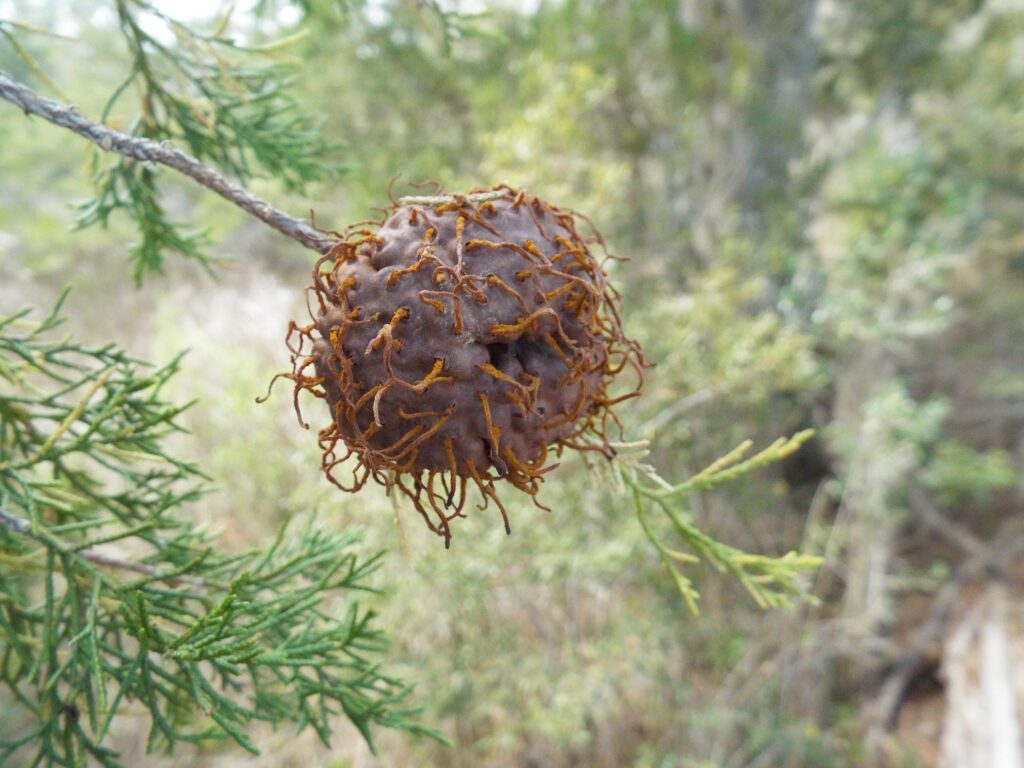
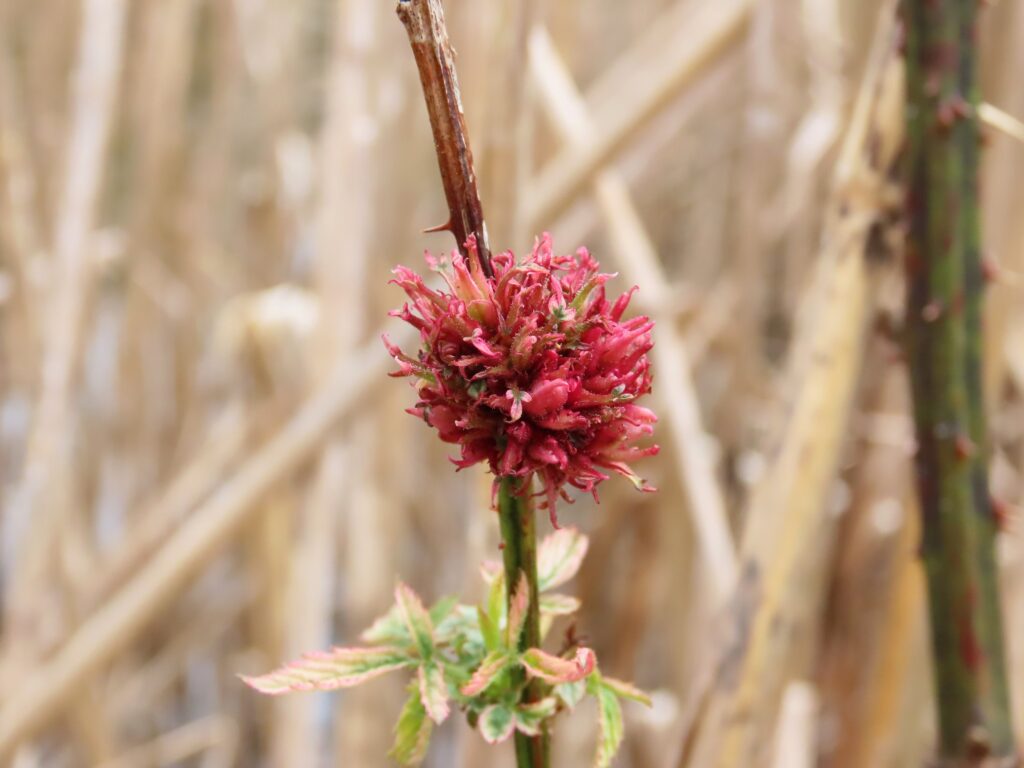
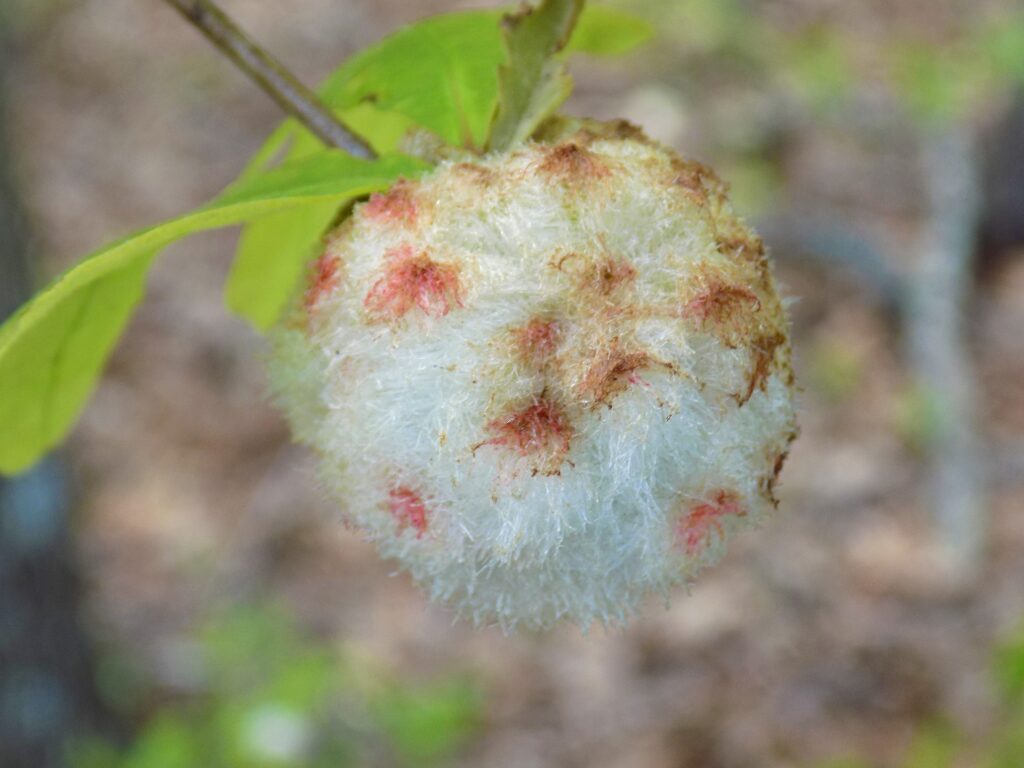

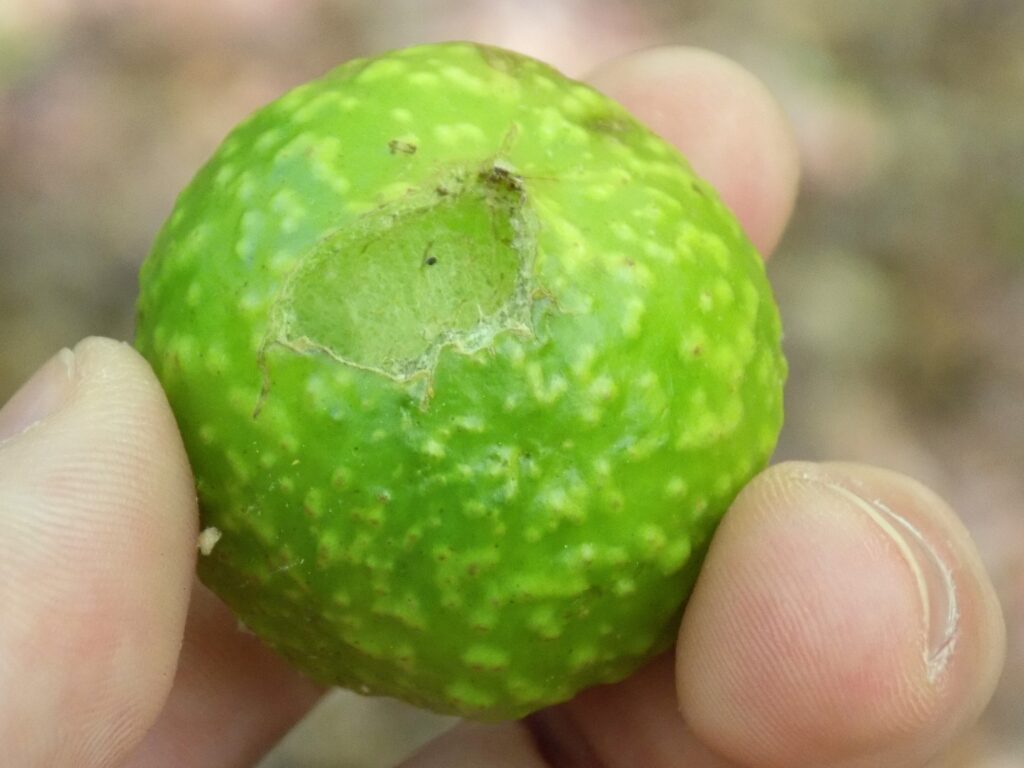
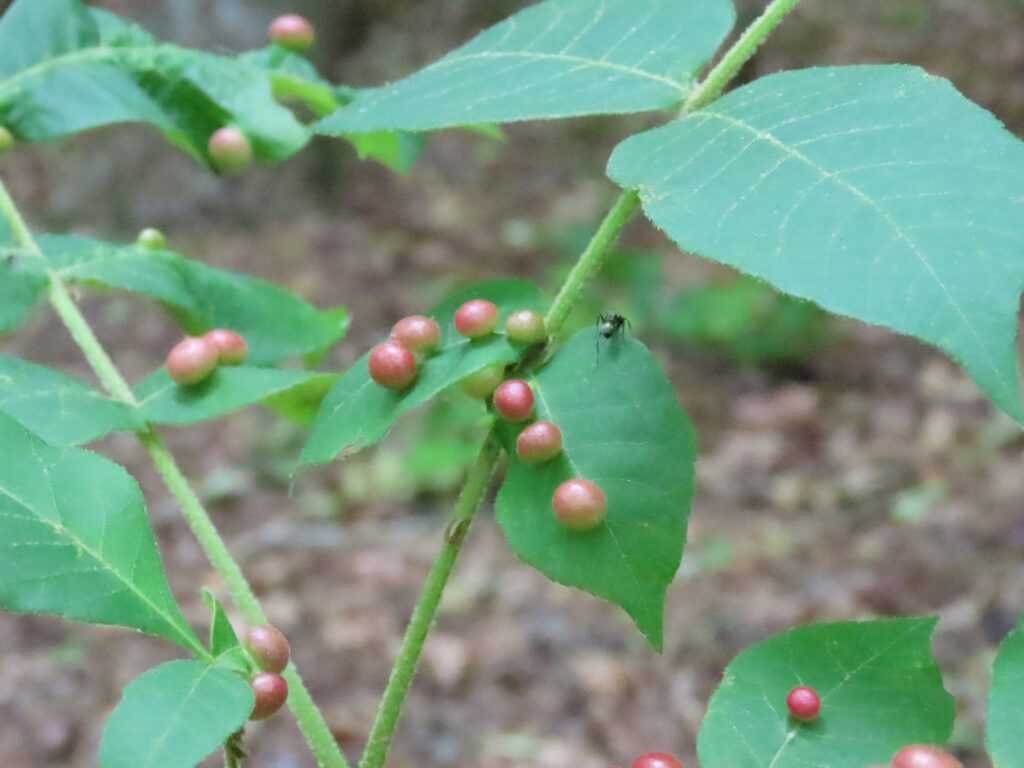
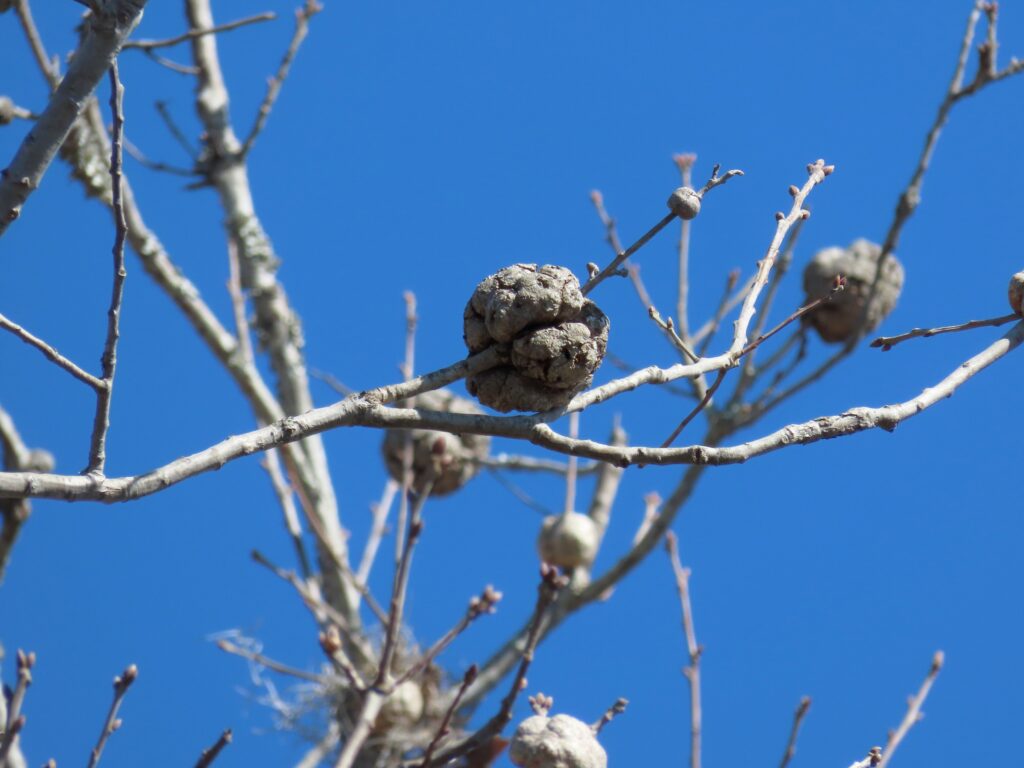
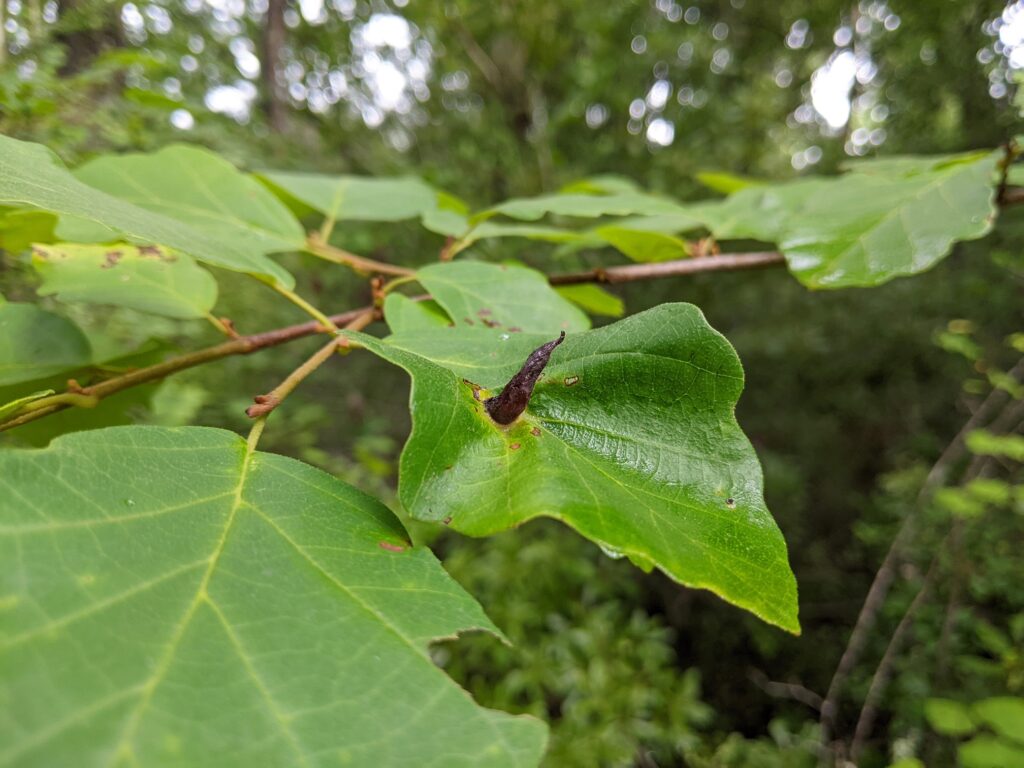

This week for Flora and Fauna Friday, we have not so much a species but an assorted collection of fascinating parasites, plant galls.
Plant galls are, ostensibly, plant tumors. However, rather than forming due to genetic degradation and mutation, like with cancer, they are instead caused by an outside force. Think of them less like cancer and more like warts. Plant galls can be formed by any manner of parasitic organism, be they a bacterium, fungus, nematode, mite, aphid, fly, moth, wasp, beetle, or something else. Due to the unique way each species of gall-forming parasite interacts with the physiology and biochemistry of the plant, each different parasite species creates their own distinct looking galls, some with incredibly intricate and well-adapted shapes.
The way a gall forms is first by a foreign organism entering the tissue of the plant. They do so either through an open wound, as with some fungi and bacteria, or, as with many of the gall-forming arthropods, by being laid in a wound created by the parent animal. Once inside the plant, the parasite starts releasing chemicals that mimic certain hormonal signals of the plant. Because plants lack a central nervous system, they communicate internally primarily through hormonal signals. By mimicking these signals, the parasite can force the tissue of the plant in its immediate vicinity to grow in very specific and peculiar ways. This often creates strange and fantastical looking growths that resemble no natural feature of the host plant. The bacterium, fungus, or invertebrate is doing this for one specific reason, free room and board. Rather than attacking the plant directly, the gall-former has tricked the plant’s own biochemistry into engulfing it with a protective shell made of nutritious plant tissue. As the parasite feasts on this newly formed gall, the plant keeps regenerating it. It’s a simply ingenious strategy. However, the plants catch on eventually and so this trick works best only during the growing season. Thus most gall-formers are adapted to take advantage of this narrow window of opportunity before going dormant until the next spring.
Plant galls can appear on any part of the plant. However, leaf and twig galls are generally the most common. Some common plant galls in our area include the following. The Goldenrod Stem Gall which is caused by a fly. Sweetleaf Gall which is caused by a fungus. Witch-Hazel Cone Gall which is caused by an aphid. Crown Gall which is caused by a bacterium. Spongy Oak Apple Gall which is caused by a wasp. Hickory Leaf Gall formed by an aphid. Lastly, Root Knot which is induced by soil nematodes and is a major agricultural pest in the Southeast.
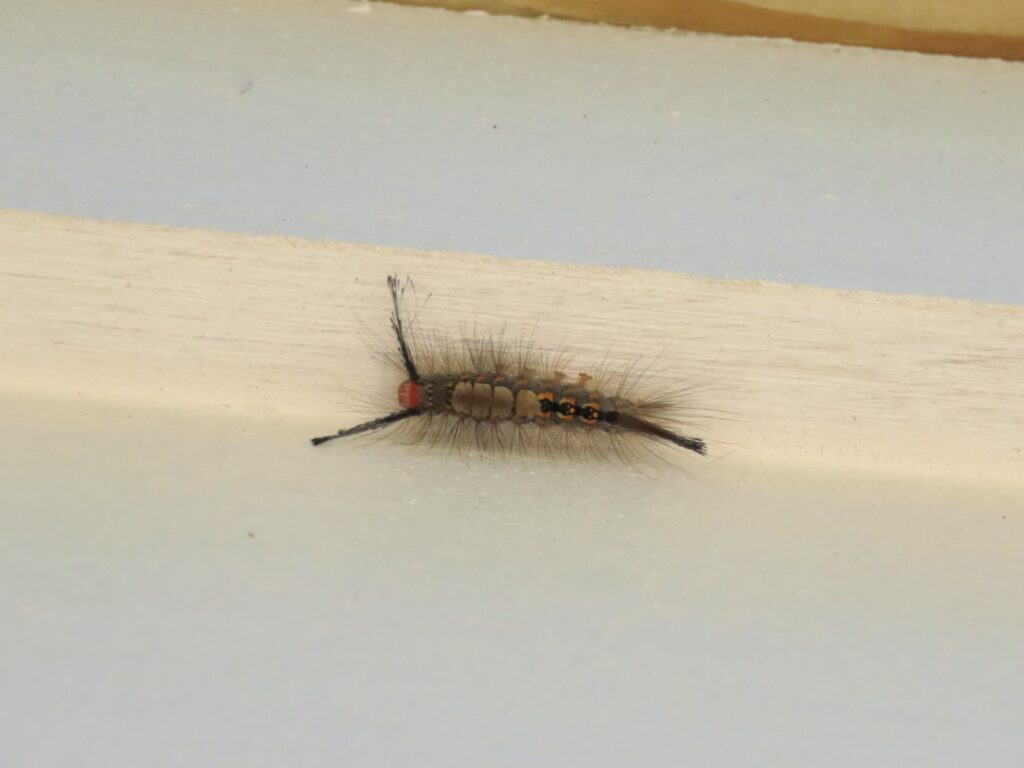

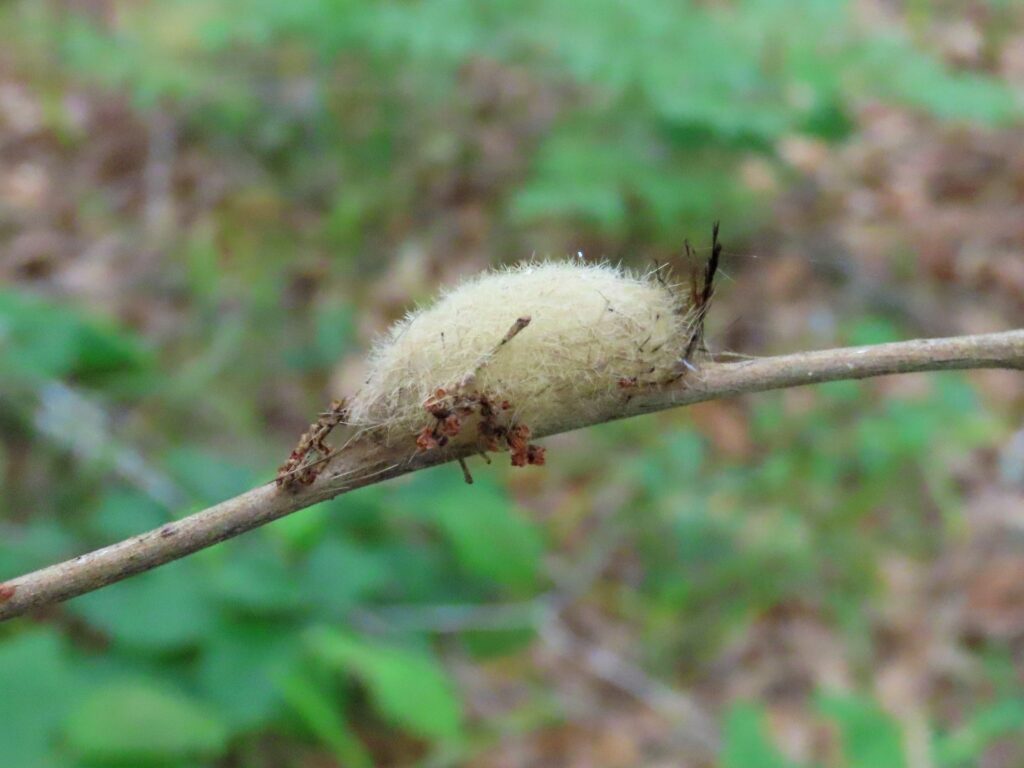
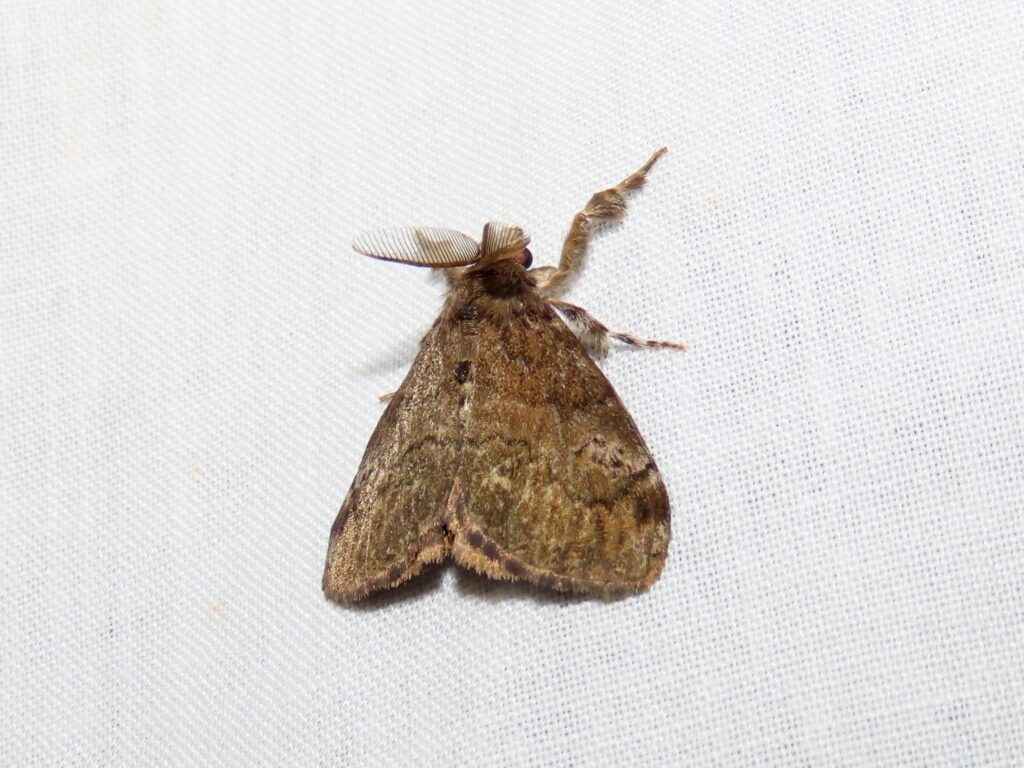
This week for Flora and Fauna Friday we have an irritating but interesting insect, the Tussock Moths (Genus Orygia).
Here in the Lowcountry we have three species of Tussock Moth: the Live Oak Tussock Moth (O. detrita), the White-marked Tussock Moth (O. leucostigma), and the Definite Tussock Moth (O. definita). Tussock Moths are most easily recognized as a caterpillar. Their larvae have a colorful head, bright orange and yellow spots and stripes, contrasting black and white markings, and are totally coated in an assemblage of various whiskers, hairs, and plumes. Their three caterpillars are very similar in appearance but easily distinguished from one another. The Definite has a yellow head, the White-marked has a set of white or yellow racing stripes down the back, and the Live Oak Tussock Moth has a red head and no white stripes.
The Live Oak Tussock Moth is definitely the most common of the bunch on Edisto Island, so it’s who I’ll focus on. Its larval host plants are principally oaks, particularly Live Oak, which is why it’s so common in the Lowcountry. The Live Oak Tussock Moth caterpillar comes in one of two color morphs, gray and yellow. The yellow is less common and is washed across its entire body with pastel yellows. The gray flavor is the prototypical morph. Its body is phosphate-gray with a thin pastel-yellow stripe on the lower flank, a line of tangerine-orange dots down the side, and a thick black stripe down the back accented with more orange spots. Their head is a vibrant scarlet and straddled by a pair of long, black, feathery whiskers. On their rear is an upward pointing black and chestnut bundle of whiskers and all along their sides is a sparse forest of stiff hairs. Yet, the most striking feature is the tussocks, four dense clumps of white or cream-colored hairs rising like a centurion’s crest from its upper back. These tussocks are not only the moth’s namesake but also the source of its infamy. Each hair in the tussock is microscopically barbed down its entire length. They’re what’s known as urticating hairs and their sole purpose is to cause irritation and itching in whatever touches the caterpillar. On top of that, each hair is attached to a tiny venom gland, which coats them in a mild venom just to make them even itchier. The “sting” of the Tussock Moth is not dangerous to humans, just highly irritating. Children are especially susceptible due to their sensitive skin along with their curiosity leading them to grab the caterpillars.
When Tussock Moth caterpillars descend from their oaken nurseries to pupate, they can become quite the nuisance. They drop to the ground and swarm out and over anything they encounter, looking for the perfect cozy crevice where they can spin a cocoon. Often your lawn furniture, siding, and eaves make the grade and they spin a cocoon there, sometimes with several caterpillars clustering together. Like most moths, their populations can fluctuate dramatically from year to year. Sometimes they’re scarce and other times they’re seemingly everywhere. Throughout this all, we mere humans can do nothing other than make way for them. Most of us, myself included, having been traumatized as curious children into a lifetime of quietly complying when these bumbling caterpillars make their yearly debut.
The tussocks play a vital role in the defensive strategy and life history of the Moth. Most obviously, they’re a defense strategy for the caterpillar. Any predator that gets a mouthful, or eye-full or nose-full, of stinging hairs quickly learns to never do that again. However, the hairs’ defensive capabilities extend beyond the caterpillar. When the caterpillar pupates, these hairs are shed and spun into the lining of its cocoon. You can often still see the caterpillar’s whiskers and hairs sticking out of the cocoon, making it look like a white dust-bunny. These hairs can retain their urticating qualities for a whole year, protecting the pupa within. However, it doesn’t stop there. The pupae metamorphose within a few weeks. The male Live Oak Tussock Moth is a small, brown, cryptically patterned moth. There’s nothing too special about him. The female on the other hand is very interesting indeed. She is not only a flightless moth but almost completely wingless! She emerges from her cocoon a ghostly white with a swollen egg-shaped abdomen. She then hangs nearby the cocoon, releasing pheromones to draw in a male. Once she’s mated, she returns to her cocoon and fills it full of eggs, coats them in a protective foam, and then rubs urticating hairs from her body into the foam. After that’s all said and done, she dies. Her eggs then lay dormant, in a very itchy cradle, until they hatch the following spring.